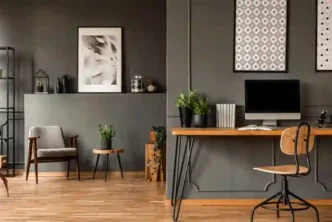Typography is one of the most important aspects of web design, playing a key role in the visual appeal, usability, and accessibility of a website. While often overlooked by some designers, typography influences how content is presented, how it is perceived by users, and how effectively a website communicates its message. From font selection to letter spacing, line height, and color contrast, every typographic decision impacts the overall user experience (UX) and design success. In this article, we will explore the crucial role typography plays in web design, its impact on branding and usability, and how you can use typography effectively to create aesthetically pleasing and functional websites.
What is Typography?
Typography refers to the art and technique of arranging type to make written language legible, readable, and visually appealing when displayed. It includes everything from font style, size, line spacing, and letter spacing to color, alignment, and positioning. Typography goes beyond just choosing a font; it involves understanding how the different elements of text work together to create an effective visual hierarchy and user-friendly interface. When done well, typography enhances the user experience, while poor typography can lead to confusion, frustration, and decreased user engagement.
- Establishing Visual Hierarchy
One of the most critical roles of typography in web design is establishing a visual hierarchy, which guides the user’s eye through the content. Visual hierarchy refers to the arrangement of elements in a way that prioritizes information and directs the user’s attention to the most important aspects of a page.
Typography contributes to visual hierarchy through several key factors:
- Font Size: Larger font sizes are typically used for headings and subheadings to draw attention, while smaller text is used for body copy to make the content easy to read.
- Font Weight: Bold fonts can be used to emphasize key points, while regular or light fonts may be used for supplementary text.
- Contrast: High contrast between text and background colors ensures that content stands out and is legible.
- Line Spacing: Proper line spacing improves readability by preventing text from feeling too crowded or cramped.
By carefully selecting typography that reinforces the hierarchy of the content, designers can ensure that users easily navigate and digest information in a logical flow. For example, on a homepage, the main headline should be the largest and boldest element, followed by smaller subheadings and body text, which provides more detail.
Why You’ll Love It:
- Guides User Focus: Typography helps users easily identify important content and navigate through a website.
- Organizes Information: Clear hierarchy improves content readability, making it easier for users to find what they need quickly.
- Engages Users: Proper typography enhances the user experience and helps guide them through the website seamlessly.
- Improving Readability and Legibility
Readability and legibility are two foundational aspects of good web design, and typography is crucial in ensuring both. Readability refers to how easy it is for users to read and understand content, while legibility is about how clear and easy the individual letters and characters are to distinguish.
Key typographic elements that affect readability and legibility include:
- Font Selection: Different fonts convey different tones. Serif fonts, like Times New Roman, are often seen as more traditional and formal, while sans-serif fonts, such as Arial or Helvetica, are considered cleaner and more modern. The right font can improve readability by matching the tone of the content.
- Font Size and Line Length: Text that is too small or too large can strain the eyes, and excessively long lines of text can be difficult to follow. Web designers should aim for a font size between 16 and 18 pixels for body text and ensure that line lengths don’t exceed 80-100 characters.
- Line Spacing (Leading): Proper line spacing (leading) ensures that the text doesn’t appear too crowded. A good rule of thumb is to set line height at around 1.4 to 1.6 times the font size.
- Contrast and Color: Sufficient contrast between text and background color is essential for readability. For example, black text on a white background provides high contrast and is easy to read.
When typography is optimized for readability and legibility, users can quickly and comfortably absorb the information on a website. Poor typography, on the other hand, can lead to user frustration, decreased engagement, and even increased bounce rates.
Why You’ll Love It:
- Easy to Read: Clear typography ensures that users can read and comprehend content effortlessly.
- Increases Engagement: Proper readability encourages users to stay longer on the website, read more content, and interact with elements.
- Reduces Eye Strain: Thoughtful font size, spacing, and color choices reduce visual strain, creating a more comfortable browsing experience.
- Creating Brand Identity
Typography is also a powerful tool for conveying brand identity and setting the tone of the website. The fonts used on a website can communicate the personality, values, and professionalism of a brand. For example, a law firm’s website will likely use a clean, formal serif font to convey authority and trustworthiness, while a creative agency might opt for more modern, playful sans-serif fonts to reflect a creative, innovative culture.
When designers carefully choose fonts that align with a brand’s voice, they create a cohesive and unified experience across all touchpoints, from the website to advertising and social media. The use of typography in branding extends beyond font selection—it also includes the consistent application of font styles, weights, and sizes to create a visually consistent and recognizable brand presence.
Why You’ll Love It:
- Expresses Brand Personality: Typography can visually communicate the essence of a brand, whether it’s professional, playful, or artistic.
- Consistent Branding: Consistent use of typography across all media channels helps build brand recognition and trust.
- Improves User Perception: Well-chosen typography makes a website look more polished and trustworthy, while poor typography can create a negative perception of the brand.
- Enhancing User Experience (UX)
User experience (UX) is all about creating a seamless, intuitive, and enjoyable experience for users. Typography plays a crucial role in UX by ensuring that text is easy to read, well-organized, and consistent with the overall design. When users find it easy to read and navigate content, they are more likely to stay engaged with the site and complete desired actions, such as making a purchase, subscribing to a newsletter, or filling out a contact form.
Typography also contributes to the aesthetic appeal of a website, which in turn affects how users perceive the brand and interact with the site. A well-designed typographic layout ensures that the user’s journey through the website feels natural and pleasant, reducing friction and frustration.
Why You’ll Love It:
- User-Centric Design: Typography enhances usability, making it easier for users to navigate and consume content.
- Aesthetically Pleasing: Well-chosen typography elevates the overall visual appeal of the website, creating an attractive user interface.
- Smooth Navigation: Clear typography contributes to a smooth, seamless user experience by guiding users naturally through the content.
- Responsive and Mobile-Friendly Design
As more users access websites from mobile devices, it’s crucial for typography to be optimized for mobile viewing. Small screens require web designers to carefully consider how text will appear on various devices, ensuring that it remains legible and accessible on smartphones, tablets, and desktops.
Responsive typography adapts to different screen sizes by adjusting the font size, line spacing, and layout based on the device being used. This ensures that the text remains readable and appropriately scaled, regardless of the screen size. Additionally, designers can use media queries to adjust typography for different viewports, providing a consistent experience across devices.
Why You’ll Love It:
- Improved Mobile UX: Responsive typography ensures that content is legible on all devices, improving mobile user experience.
- Flexible Layouts: Typography that adapts to screen sizes enhances the usability of websites across different devices.
- Greater Accessibility: Ensuring readability on all devices makes your website more accessible to a wider audience.
- SEO Benefits of Typography
While typography primarily affects the user experience, it can also have an indirect impact on SEO (Search Engine Optimization). Google and other search engines prioritize websites that provide excellent user experiences, and good typography plays a significant role in this. When users can easily read and navigate a site, they are more likely to stay longer, interact with the content, and engage with calls to action—all of which are positive signals to search engines.
Additionally, text readability and structured typography help search engines crawl and index content more effectively. Using proper heading tags (H1, H2, H3, etc.) helps search engines understand the structure and hierarchy of the content, which can positively influence search rankings.
Why You’ll Love It:
- Improved SEO: Proper typography encourages better user engagement, which can improve SEO rankings.
- Content Structure: Heading tags and other typographic elements help search engines understand the page content.
- Better User Metrics: A well-designed website with readable text leads to lower bounce rates and longer session durations—factors that can enhance SEO performance.
Conclusion
Typography is far more than just an aesthetic choice—it plays a vital role in web design success by influencing readability, usability, branding, and overall user experience. By thoughtfully selecting fonts, adjusting spacing, and ensuring consistency across devices, designers can create websites that are not only visually appealing but also functional and user-friendly. Whether you’re designing a personal blog, an e-commerce site, or a corporate landing page, the right typography can significantly improve the user experience and enhance the success of your website. As you embark on your next web design project, remember that typography is not just about choosing a pretty font—it’s about crafting a seamless and engaging experience for your users.





